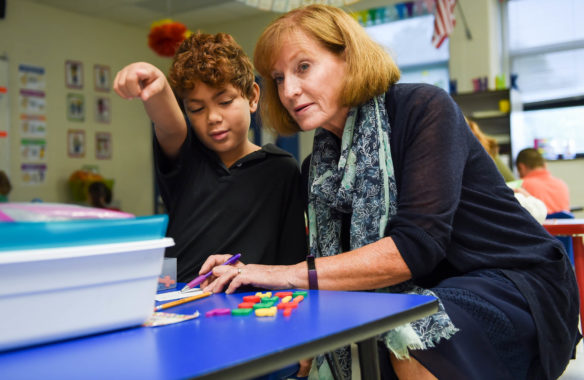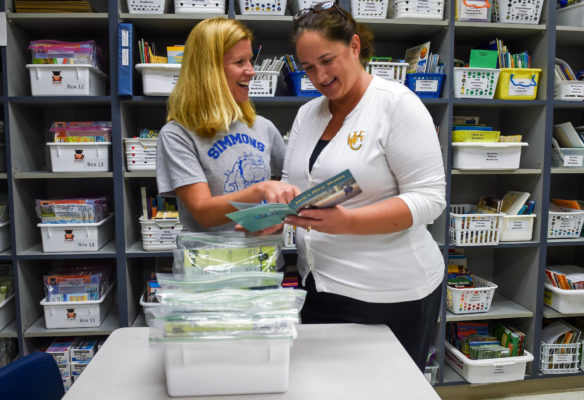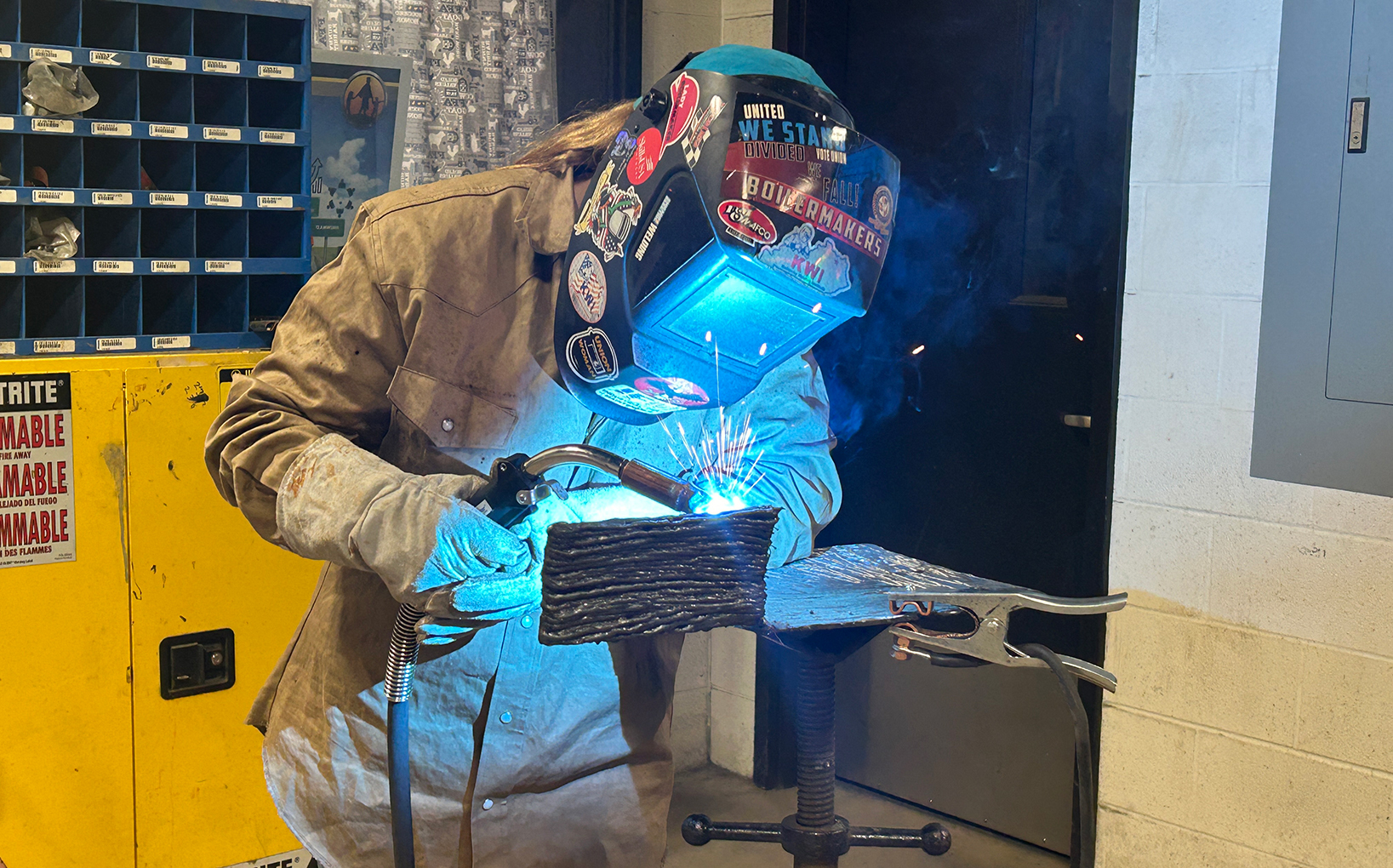
Literacy Coach Debbie Baker works with Desmond Hernandez, a 2nd-grader at Simmons Elementary (Woodford County), on building words with magnetic letters. The school uses the letters, white boards and sound boxes to help students build literacy skills.
Photo by Bobby Ellis, Oct. 9, 2017
By Brenna R. Kelly
Brenna.kelly@education.ky.gov
Tiffany Cook came to Simmons Elementary with a mission.
Cook, who became principal of the Woodford County school in 2016, knew her biggest challenge was getting her students to reading proficiency by 3rd grade.
At the beginning of the 2016-17 school year, 40 percent of kindergarten through 3rd-grade students were reading below grade level, with 51 percent of 1st-graders below grade level. In the incoming kindergarten class, 64 percent arrived at the school unprepared.
“We knew we had to build that literacy foundation from the bottom up,” Cook said. “And that’s exactly what we did.”
First, Cook prioritized her budget to focus on literacy. That meant hiring a literacy coach, creating a book room in the school and buying materials for guided reading.
Cook knew that guided reading, a method of reading instruction that uses small groups to allow teachers to provide differentiated instruction, was the best hope for her students. The district also promoted the use of guided reading, she said.
Once the resources were in place, Cook set out to create a plan to use them, build trust with the teachers and create a culture of professional learning. Cook presented her strategy to a standing-room only crowd at the Kentucky Department of Education and AvancED Continuous Improvement Summit in September.
Cook said she could have hired a reading intervention teacher to work with students, but decided that a literacy coach would help teachers improve their reading instruction and therefore, actually reach more students.
Cook hired Debbie Baker, who had been a Reading Recovery teacher and is trained in comprehensive intervention, as a literacy coach.
“My goal is to increase the level of teacher expertise in the building,” Baker said.
To do that, Baker started by meeting with grade-level teachers during their weekly common planning time to work on guided reading instruction. That allows her to break down training into short segments and to focus on what the teachers say they want to work on, Baker said.
“When you hear it all at once, it’s like, ‘Sure it sounds good, but I can’t implement all that,’” she said. “If I give them a small thing to go back and implement in the classroom, it’s a lot easier.”
Bakers uses Jan Richardson’s “The Next Step Forward in Guided Reading” to work with teachers. She shows them videos of teachers and practices lessons with them. She even helps them plan lessons with the appropriate books for their small groups.
But Baker also spends time in the classroom, where she can model the lessons for teachers and show them how it works with their own students.
“I think the most valuable piece, even after all of the training, is that actual modeling,” she said. “When they see it and know that you can actually accomplish it with other kids in the room and work out all the kinks, that is the most powerful thing.”
Baker brings the teachers into the lessons and coaches them as they slowly take over. Baker makes sure the teachers know she isn’t there to evaluate them, but to work with them.
Gaining the trust of the teachers allows literacy coaches to have the most impact on teaching and learning, said Whitney Hamilton, the Kentucky Department of Education’s elementary literacy consultant.
“When coaches become part of the classroom environment before, during and after instruction, and provide nonjudgmental side-by-side support to teachers,” she said, “they can help teachers develop, deliver and refine best practice literacy instruction.”
Baker even asks the teachers to critique her lessons. They discuss why something didn’t work the way she had planned or why a book didn’t work for a particular small group and then figure out which book would have been a better choice.
Simmons teacher Rose Thrush thought she knew how to teach reading after 27 years, but she has been amazed at what she has learned from Baker.
“It’s a game changer,” she said. “It has just breathed new life into teaching. I thought I was doing it the most efficient way possible all these years. I’d been taught how to do the same method she uses, but she brings so much more to it. She takes us to a higher level.”
All the teachers now have a common language around reading.
“We are trying to get it as unified as we can so that, especially with our struggling readers, they are seeing the same things over and over again,” Baker said. “This really helps them to not be confused.”
To do that, the school implemented a 120-minute literacy block for all grades, a common alphabet chart so that all teachers and students would be looking at the same picture and letter combinations, and common sight words lists and handwriting charts.
“The consistency across classrooms, across intervention teachers, ELL teachers, special education teachers is important,” she said. “If you’re a child and do not know your sounds, you have to have a way to learn those sounds and one common way is a picture clue, a hook.”

Kim Haury, a teacher at Simmons Elementary (Woodford County), left, and Principal Tiffany Cook pick out a book from the leveled book room that the school created for use with guided reading instruction.
Photo by Bobby Ellis, Oct. 9, 2017
One of the things that makes the system work is the Book Room, which is organized by level, nonfiction, fiction and read-aloud. The school had book room, but it wasn’t organized, they said.
“It was not a book room, it was a room with a lot of books in it,” said Cook, who got the idea from Picadome Elementary, where she an assistant principal. The Fayette County school had a similar leveled-book room, she said.
Thrush said the book room has made her guided reading lessons much easier to plan and implement.
“It’s completely organized. Any topic at any level, you can just walk in and there it is,” Thrush said. “It’s so powerful to have books that are specifically designed for every specific level, so they are matched to the child exactly at that child’s stage of development in reading.”
The school uses white boards, magnetic letters, reading strategy cards and book bags so that students can take the books home with them. There’s also a data wall where the teachers, Cook and Baker can all see at a glance where there might be problems.
This year the school received a Read to Achieve grant that allowed them to hire a reading intervention teacher. The teacher is using Reading Recovery with eight students and doing targeted instruction with eight small groups.
“We’re able to cast a wide net,” Cook said. “The coaching and the modeling and the things the classroom teachers are able to see from the literacy coach and now with the Read to Achieve teacher, I think that’s where we’re seeing the real improvement.”
In fall of 2016, a Measure of Academic Progress (MAP) test showed that 47 percent of kindergarten through 2nd-grade students performed at the novice level. On the spring MAP test, just 25 percent performed at the novice level, Cook said.
On the K-Prep reading assessment for 3rd grade in 2015-16, 60 percent of students performed at the novice or apprentice level. In the 2016-17 results, 46 percent of 3rd-grade students performed at the novice or apprentice level.
“I have to remind myself that this is a three-year plan, we can’t fix it in one year,” Cook said. “We have worked very hard, but we still have a long way to go.”
MORE INFO …
Tiffany Cook Tiffany.Cook@Woodford.kyschools.us
Debbie Baker Debbie.Baker@Woodford.kyschools.us
Rose Thrush Rose.Thrush@Woodford.kyschools.us
Whitney Hamilton Whitney.Hamilton@Education.ky.gov



Effective reading instruction, structured literacy.
https://dyslexiaida.org/effective-reading-instruction/